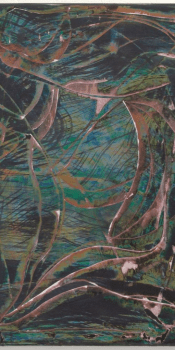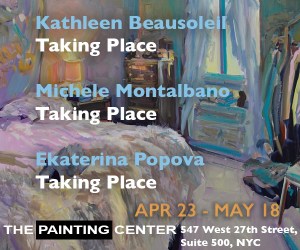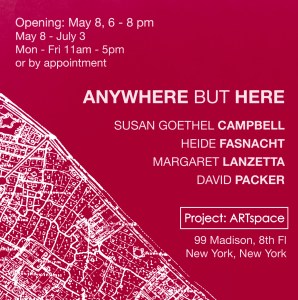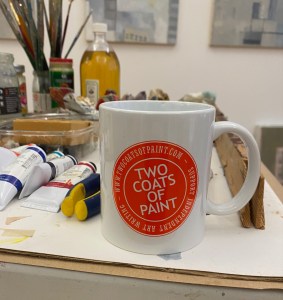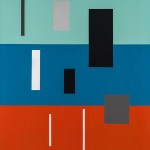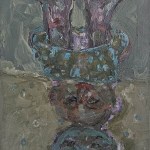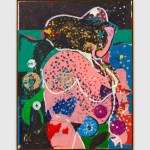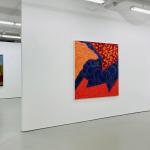Contributed by Sharon Butler and Jonathan Stevenson / Hitting the road to Alabama for Sharon’s solo show “March” at the Sarah Moody Gallery at the University of Alabama in Tuscaloosa in late March, we knew from ongoing contact with gallery director and art professor William Dooley and his assistant Vicki Rial that a deftly curated presentation in a beautiful space and a warm reception from the Art Department were in store. The students and gallery patrons who attended Sharon’s artist’s talk were inquisitive, smart, and welcoming. What we did not expect was the prevalence of so many talented people in the wider art community spanning Tuscaloosa and Birmingham, which we discovered is rich with deeply engaged artists, curators, and gallerists.
Recent Posts
Christina Ramberg’s powerfully personal eroticism
Contributed by Laurie Fendrich / The erotically charged art of Chicago Imagist painter Christina Ramberg (1946–1995), whose retrospective is currently on view at the Art Institute of Chicago, aligns chronologically with the second-wave feminism of the 1970s and 80s. Today’s third-wave feminists (some say it’s now fourth-wave) frequently disparage that incarnation of the movement for privileging white women’s worries, and worse, for its obliviousness to institutional misogyny. Fortunately, Art Institute curators Mark Pascale and Thea Liberty Nichols don’t try to pigeonhole Ramberg’s work into that framework. Although she considered herself a feminist, an aggrieved one she was not. Her art was personal, not political, and it doesn’t fit neatly into standardized versions of feminism. Remarkably, the artist found a way to mix together sharp and provocative subject matter about women’s desires with a classical, pristine aesthetic.
Ron Milewicz’s Thoreauvian sensibility
Contributed by Michael Brennan / If you are interested in the ongoing relevance or advancement of landscape, Ron Milewicz’s current exhibition “Second Sight” at Elizabeth Harris Gallery is for you. Milewicz, who has taught for decades, is an expert hand at drawing, painting, and, most importantly, seeing.
Hudson Valley (and vicinity) Selected Gallery Guide: May 2024
Contributed by Karlyn Benson / Spring is in full bloom and it’s one of the most beautiful times of year upstate. I’m looking forward to Chie Fueki: Petal Storm Memory, curated by David A. Ross at Kino Saito in Verplanck, NY, opening May 11. Farther north there are two notable shows opening on May 18 in Kinderhook: Other Realities (Exploring Proximate Mysticisms) at Bill Arning Exhibitions and Annie Bielski, Raw Footage at SEPTEMBER. Also opening May 18 is the Wassaic Project’s summer exhibition Tall Shadows in Short Order. I recommend visiting Pamela Salisbury Gallery in Hudson to see Lothar Osterburg’s extensive solo exhibition, A Celebration of the Small, featuring a collection of models, installations, and photogravures from the past twenty-five years. There are too many great exhibitions to mention here, so take a look at the list below and get ready for a road trip.
NYC Selected Gallery Guide: May 2024
Welcome to the early edition of the Two Coats painting-centric guide to May art exhibitions in Manhattan, Brooklyn, and Queens. Notable, must-see shows in Brooklyn include Emily Janowick at International Waters, Emily Roz at Auxilliary Projects, and Charlotte Zinsser at Haul. In Manhattan, Julia Bland has a new series of monumental woven and painted pieces at Derek Eller and Joanne Greenbaum is having her first solo at Mitchell-Innes & Nash. Check out Two Coats contributors Anna Gregor at D.D.D.D. Projects and Natasha Sweeten at Satchel Projects. We also recommend Jennifer Coates at both HIgh Noon and Chart, Lesley Vance at Bortolami, Rachel Eulena Williams at Canada, and Amy Sillman at Gladstone. And then, don’t forget, we will have a slew of art fairs in our midst. We’ll be heading to the Future, NADA, and Independent fairs. See you out there.
Lucy Puls: Meaning in obsolescence
Contributed by Talia Shiroma / Pink teddy bears, plastic ponies, and the blank face of a Mac 512 computer peer out from blocks of amber murk. They are among the discarded goods on display at Nicelle Beauchene Gallery as part of Berkeley-based artist Lucy Puls’s solo show, spanning works created between 1989 and 2003. For the series In Resin, which she began in the early nineties, Puls amassed secondhand items from thrift shops and encased them in translucent resin prisms. Ranging from a BB gun to records, these once-coveted objects now register as curiously impotent, floating in their chambers like specimens in jars. Although they are up for sale once more, the encased objects feel unobtainable, as if quarantined from both time and human desire.
Joe Bradley: Merging night and day
Contributed by Natasha Sweeten / On a warm, sunny day that teased people outdoors, I stepped into Zwirner to catch Joe Bradley’s current exhibition, “Vom Abend.” Nine large paintings gleamed within the pristine gallery. I’d in fact been on my way to see another show, but at Zwirner I lingered and I looked, unexpectedly beguiled. Pretty soon I relaxed and accepted I’d be here a while.
Xingze Li and Sarah Pater: Extraordinarily quotidian
Contributed by Michael Brennan / As a close follower of the emerging art core in South Brooklyn, I seldom miss an exhibition at Yi Gallery. Its shows are invariably interesting and novel, perfectly and poetically installed. The primary space is currently featuring a nicely integrated two-person show of Xingze Li and Sarah Pater’s work, with individual exhibitions for each artist in the back.
Ian Myers: A painter’s faith
Contributed by Anna Gregor / Ian Myers’ paintings blur the lines between art, nature, and miracle, asking what painting’s vocation is at a moment when anything can be art, nature is under threat, and miracles are unfathomable. His five paintings, on view in his solo show “immortal flub” at New Collectors Gallery, are obviously art. Rectangles do not occur in nature, nor do the white gallery walls on which his rectangular paintings hang. But these rectangles don’t act like windows that allow us to enter an illusionistic space, as we expect from mimetic paintings. Nor do they reveal the human hand or thought processes that we assume to be involved in making abstract work. They eschew the exhibitionist gesture of Abstract Expressionism, the clarity of hard-edge abstraction, and the planned step-by-step process of much contemporary abstraction.
Farrell Brickhouse: The beat goes on
Contributed by Jonathan Stevenson / Farrell Brickhouse’s recent paintings, on view at JJ Murphy Gallery, embody aging and stamina and the grungy inventiveness that comes with them. In these terms, perhaps the signature piece is Summers End II, tucked away all by itself in the gallery’s rear alcove. Just a foot-and-a-half square, it is a still life of Rauschenberg-grade grit that holds court, depicting what looks like a vase of motley flowers on a stand, waning but defiant in the face of time. Distressed as they are, they look not just alive but capable of aggression. The work is textured in the extreme, Brickhouse having affixed to the canvas the congealed detritus of students’ pigment and painted thickly around it. It’s as though Chaïm Soutine or Frank Auerbach had possessed Morandi and gone to town.









